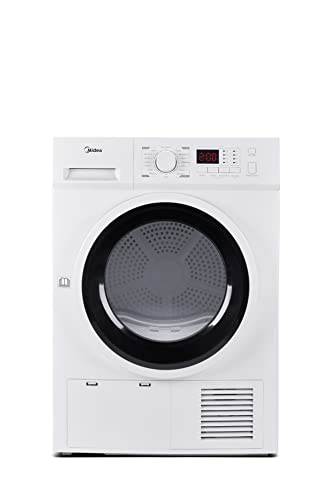What Is Heat Pump Tumble? Heck What Is Heat Pump Tumble?

Heat Pump Tumble Dryers
These tumble dryers are equipped with the latest energy-saving technology that helps you conserve and reuse the air drained from your laundry. They may be more expensive in the beginning but they're a great option for anyone looking to save money while doing their part for the environment.
They are also less expensive to run than condenser or vented models. In fact, they can help you save PS42 to PS51 per year on your energy bill.

They're more affordable to run
Since they consume less energy to dry your clothes the tumble dryers with heat pumps are a lot less expensive to run than condenser or vented models. They recycle warm air, making them more eco-friendly. In fact, if you select an A-rated model such as the Bosch H-DRY 500 (Heat pump) - Hoover Direct that's equipped with smart connectivity and a smartphone application, you can save up to PS91 annually on electricity bills.
They can be more expensive than other tumble dryers. However they can pay for themselves with lower energy bills quickly especially in winter when the highest prices for a long time.
Contrary to vented and condenser tumble dryers, which release warm air after they finish their drying cycle, heat pump dryers recycle it back into the drum. This means they're more efficient and less expensive to run - by up to 50% cheaper in actual.
Since they operate at lower temperatures, your clothes receive better protection as well. Hot air can shrink fabrics and cause necklines to become misshapen or fade prints. However, your clothes will last longer when you use a heat pump tumble dryer.
Another benefit of the heat pump tumble dryer is that they don't need to be plumbed in. They have a reservoir that you can empty and use in your sink. This lets you install them wherever, even near a socket.
Although they may take longer to dry your laundry than condenser or vented tumble dryers, they often feature built-in sensors that stop the machine once it's finished and you don't have to fret about letting your clothes hang too long. They'll inform you when the tank is full, so you can empty it prior to the next wash.
Remember that heat pump tumble dryers are more sensitive and won't dry all types of fabrics. This is because they run at a lower temperature. Some fabrics, such as silk and wool, will not dry in a proper manner.
You'll feel better about your clothes
Contrary to condenser models and vented models that are vented and condenser models, heat pump tumble dryers do not require vents on the outside. This lets them be put anywhere in the house, especially when you live in a tiny apartment with no outdoor space.
Additionally, a heat pump tumble dryer operates at a much lower temperature than traditional tumble dryers. This is better for clothes as it protects against the wear and tear that occurs when you tumble dry at a high temperatures. This will stop your favorite clothes from shrinking or becoming distorted and distorted, which is a problem when you have many in your wardrobe.
A heat pump tumble dryer is operated in a different way than a regular dryer, employing a closed-loop system to recycle warm air. It is able to reach the desired temperature by blowing air over an element that heats it, and then it passes the hot air over an evaporator to eliminate moisture. This is then collected into a tank or drained, prior to being heated and then returned to the drum to dry your clothes.
In this way the heat pump tumble dryer can save you money by reducing your energy costs and also keeping your clothes looking good for longer. Heat pump tumble dryers might take a bit longer to dry, but the benefits far outweigh this. It is important to realize that heat pump models require some additional maintenance. The water reservoir needs to be regularly emptied and the evaporator should be cleaned on a regular basis. They may also be a bit slower in the beginning of drying than vented models, but that's because they work at temperatures that are lower.
You'll feel softer on your clothes
It's not just the environment that gains from heat pump tumble dryers They're also gentler on your laundry. Since they don't add heat to the air, they operate at lower temperatures than vented dryers, which means your clothes will not suffer wear and tear that comes from high levels of humidity. This is a good thing for delicate fabrics like wool and silk.
The tumble dryers with a heat pump do not have an exhaust vent to let the moist air out, like a conventional electric dryer would. Instead, they utilize an evaporator, which absorbs the moisture in the clothes and removes it. The warm air that is generated is then reheated which aids in drying your clothes. This closed-loop design means you do not have to worry about removing moisture with an external vent.
The lower temperatures also mean that your clothes will last longer as you won't have to wash them over and over again when they shrink or become damaged from repeated drying at high temperatures. more info -end models are even more gentle, since they use moisture sensors to calculate the ideal drying time. This ensures that your clothing is not drying too fast or too slow.
Also, unlike vented dryers, heat pump tumble dryers don't need to be connected to an external vent, which means you can put them in any place in your home. You will also need to empty the dryer's tank regularly, usually after each wash or at least once a month. This is just the same from any other tumbler.
They're quieter
One of the main benefits of using heat pump tumble dryers is that they don't make much noise. They are more quiet than conventional condenser dryers. This makes them ideal for households with busy schedules. They use coolant, which lets them operate at a lower temperature. This means that clothes will last longer.
It's important to remember that tumble-dryers with heat pumps still produce noise. It's usually caused by the compressor and the fan. The good news is that noise can be greatly reduced through regular maintenance. This means making sure that any loose parts are tightened, that there's no banging or rattling, and that the machine is properly lubricated to ensure that noises like screeching and whining are eliminated.
To minimize the noise, installers can select heat pumps that are Quiet Mark approved as they have been shown to offer the quietest levels of operation. In addition, installers can search for acoustic liner and insulation to minimise the sound of the unit. Installers should also ensure that indoor and outdoor heat pump units are placed away from living areas to minimize the noise.
Heating systems can be made more quiet by making use of noise reduction technology. Grommets made of rubber on mounts, Acoustic cabinets, and insulation within ductwork can all help muffle noise. Inverter-driven air compressors are also an excellent option, since they can be adjusted to speed to prevent the initial surge of energy needed when the compressor is started that often causes high-pitched sounds.
Although all mechanical systems generate some noise It's important to remember that a heat pump is a far better choice than traditional fossil foil boilers. It's an efficient alternative that saves you money and keeps your clothes looking fantastic. The tumble dryers with a heat pump offer a more eco-friendly option. Why not make the switch?
